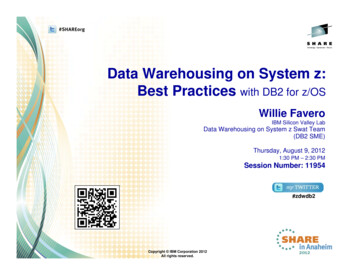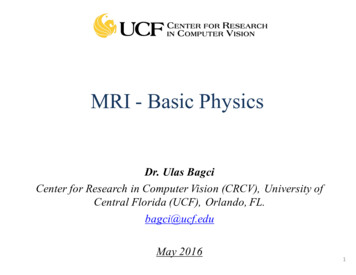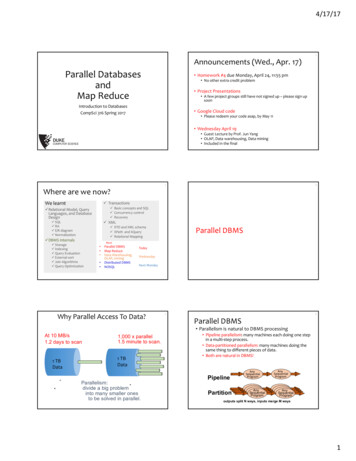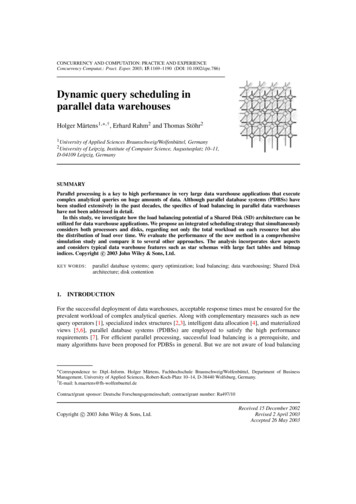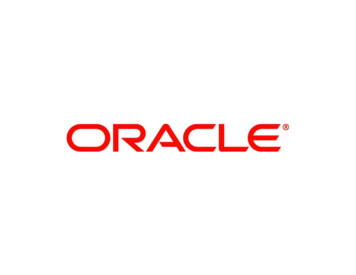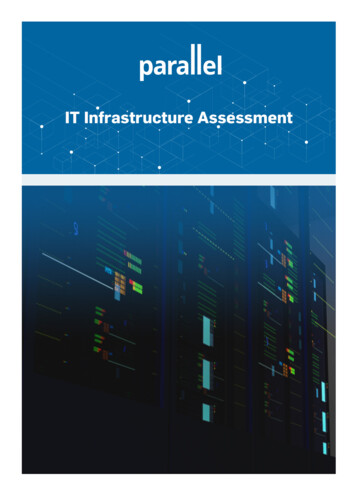
Transcription
IT Infrastructure AssessmentService OverviewParallel’s IT Infrastructure Assessment is a comprehensive audit and assessment of all core IT infrastructure components, includingservers, storage, network, backup, and disaster recovery. The purpose of the assessment is to provide an up-to-date and detailedview of the entire IT infrastructure, including resource utilisation statistics, to assist with planning and sizing for infrastructureupgrades, datacentre migrations, IT outsourcing, or cloud migration projects. The assessment can also be used to plan and size forconverged infrastructure projects such as general-purpose workloads, virtual desktop infrastructures, analytics, and remote or branchoffice workloads (ROBO).IT Infrastructure Assessment Features Audit of all physical and virtual servers incl. OS configuration and application version detailsAudit and assessment of servers, storage, virtualisation, network, backup, and disaster recovery infrastructuresServer and storage utilisation metrics for all servers in-scopeIT Service Catalogue and Service Group definitionService Classes for DR (e.g. Gold, Silver, Bronze) to all servers in the IT Service CatalogueGap analysis to identify servers that require DRWorkshops to capture additional information to be included in the IT Service CatalogueIdentify servers that should be decommissioned to free up resourcesIdentify servers that can be virtualised to reduce physical datacentre footprintDetailed capacity and performance sizing spreadsheets for compute and storageClassify all servers for cloud migration using Replace, Refactor, Revise, Rehost, RebuildApplication Dependency MappingOur ApproachParallel’s Infrastructure Assessment involves a three-stage process of, Discovery, Analysis and Recommendations.Discovery: In this phase data is gathered both manually and using automated data capture tools. Additional information will becaptured through workshops with your team.Analysis: Once our consultants have gathered all relevant information, it will be analysed and a number of reports will be produced.Recommendations: Exec Summary presentation and Infrastructure Assessment Report, with recommendations on immediatesystem improvements, as well as resource utilisation statistics and sizing, to assist with planning for infrastructure upgrades,datacentre migrations, IT outsourcing, or cloud migration projects.Assessment Deliverables Exec Summary presentation IT Infrastructure Assessment Report and Information PackThe Infrastructure Assessment Information Pack will contain the following assessments: Server Workload Assessment (physical and virtual) Virtualisation Assessment Storage and Replication Assessment SAN Switch Assessment Network Assessment Backup & DR AssessmentThe following documents will also be included in the IT Infrastructure Assessment Information Pack: IT Infrastructure Assessment Database Service Catalogue Sizing for Storage & Compute Application Dependency Mapping Candidates for P2V, DR and DecommissioningThe assessment deliverables include a number of insightful reports regarding your environment. A few examples are shown below.For more information, please go to www.parallel-it.com or email info@paralel-it.com
IT Infrastructure AssessmentIT Service Catalogue ExampleAn IT Service Catalogue is a list of IT Services delivered by IT to the business. IT Service Groups contain one or more servers runningvarious applications specific to that IT Service. Parallel can work with your team to define suitable Service Groups and then assignall servers to those groups based on their function within the business. This can be extremely useful for planning where futureworkloads should reside, based on how critical they are to the business.Service Classes ExampleService Classes are defined to group applications based on how critical they are to the business and how quickly they need to bereturned to service after an outage. The level of service provided by each Service Class is best described using the terms ‘RecoveryPoint Objective’ and ‘Recovery Time Objective’.Recovery Point Objective (RPO) - The maximum tolerable period in which data might be lost from an IT service/application due toa major incidentRecovery Time Objective (RTO) - The duration of time within which a business service/application must be restoredThere are many different scenarios where an outage could affect a specific service or application. A single application failure at theproduction site is different from a site failure where DR must be invoked and multiple services/applications recovered simultaneously.The business may accept a longer RTO in a site disaster scenario. For this reason, each Service Class can have different servicelevel objectives for local failures and site failures.For more information, please go to www.parallel-it.com or email info@paralel-it.com
IT Infrastructure AssessmentData Storage Assessment for Capacity and Performance GrowthIf historical capacity and performance metrics are available, the Data Storage Assessment will include charts on storage growthtrends.Capacity (TB) Growth TrendPerformance (IOPS) Growth TrendData Storage Assessment for Performance UtilisationThe Data Storage Assessment includes performance metrics e.g. Read/Write IOPS, Read/Write Bandwidth MB/s, Response Timeetc. For reporting purposes this information can also be mapped to server and service groups. Any performance issues identifiedare included in a RAG report with recommendations for remediation.Data Storage Assessment for Replication Link UtilisationUtilisation metrics for storage replication is also included in the reports.For more information, please go to www.parallel-it.com or email info@paralel-it.com
IT Infrastructure AssessmentData Storage Assessment for Profiling of Unstructured DataThe Data Storage Assessment includes a review of your servers or NAS filers that contain unstructured data. The reports show howmuch data is active and what type files are being stored. This information can be used to determine whether there is a case forarchiving, or moving infrequently used data to a lower-cost tier of storage such as public or private cloud.Last AccessedLast ModifiedLast Accessed by CapacityLast Modified by CapacityLast Accessed by File TypeFor more information, please go to www.parallel-it.com or email info@paralel-it.com
IT Infrastructure AssessmentData Storage Assessment SizingIf required, storage sizing can be added to the scope of the assessment. Our consultants will work with your team to complete thestorage performance and capacity sizing and then document the calculations for inclusion in a storage requirements specificationdocument or RFP.The following tables provide an example of a storage capacity and performance sizing exercise:Growth EstimatesCapacity Sizing Summary (TB)Performance Sizing Summary (IOPS)Capacity Sizing (TB)Performance Sizing (IOPS)Detailed utilisation statiscics for individual servers:For more information, please go to www.parallel-it.com or email info@paralel-it.com
IT Infrastructure AssessmentVirtualisation Infrastructure AssessmentThe Virtualisation Assessment includes a review of your virtualisation environment and identifies any issues with the currentconfiguration, and provides recommendations for optimisation. Identifying opportunities to right-size or even decommission serversprior to a migration project can have a significant impact on the planning and sizing of the target platform or solution.For more information, please go to www.parallel-it.com or email info@paralel-it.com
IT Infrastructure AssessmentFor more information, please go to www.parallel-it.com or email info@paralel-it.com
IT Infrastructure AssessmentCompute Assessment SizingIf required, compute sizing can also be added to the scope of the assessment. Our consultants will work with your team to completethe compute performance and capacity sizing and then document the calculations for inclusion in a compute requirementsspecification document or RFP.The following tables provide an example of a compute capacity and performance sizing exercise:Growth Estimates:Summary of utilisation including growth estimates:Detailed utilisation statiscics for individual servers:For more information, please go to www.parallel-it.com or email info@paralel-it.com
IT Infrastructure AssessmentBackup Assessment Key Facts ReportThe Backup Key Facts Report shows how much data is backed up, broken down by the backup type, e.g. Filesystem or Exchange.The report also shows the total number of clients with backup images available for recovery.Backup Assessment Throughput ReportThe Backup Throughput Report shows when the backups are run, total throughput for the backups, and how many backup job areconfigured to run concurrently. It also clearly shows when backups overrun their official backup windows.Backup Assessment Pool and Retention ReportThe Backup Pool and Retention Report shows how much backup data is being stored and for how long.1 DayBackups (TB)604 Weeks5 Weeks1 Year10 Years21 Years, 5 Months21 Years, 6 Months22 Years40200Fri.07/22Fri.07/29Fri.08/05Fri.08/12For more information, please go to www.parallel-it.com or email info@paralel-it.comFri.08/19
IT Infrastructure AssessmentApplication Dependency MappingApplication Dependency Mapping has become a crucial tool in planning complex and large scale infrastructure migration projects.Understanding the relationships between various servers can provide invaluable information about what components should be keptor moved together to avoid the risk of introducing latency or other unforeseen problems.To book this service, or to speak to one of our consultants, please contact us at info@parallel-it.com or via our website atwww.parallel-it.com.For more information, please go to www.parallel-it.com or email info@paralel-it.com
IT Infrastructure Assessment For more information, please go to www.parallel-it.com or email info@paralel-it.com Service Overview Parallel's IT Infrastructure Assessment is a comprehensive audit and assessment of all core IT infrastructure components, including servers, storage, network, backup, and disaster recovery.

